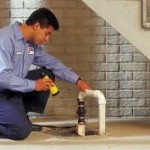
Regular inspection and maintenance of your sump pump can keep you out of deep water.
As we move into Spring, we certainly welcome the warmer temperatures and longer days. However, the change in seasons also brings melting snow, rain and wind.
In Buffalo and Western New York, our goal is to keep the water and elements of weather outside and our homes dry on the inside. Unfortunately, power failures and other circumstances sometimes prevent us from achieving these goals – so we want to be prepared.
As a leading home inspection company in Western New York, we have found one of the best things you can do to be prepared is to make sure your sump pump is properly installed and working.
1) Ideally, you should check your sump pump every 2-3 months and when heavy rains or storm events are forecast for your area.
2) Make sure the sump pump is plugged into a properly rated electrical outlet. In the course of our home inspections throughout Buffalo and all of Western New York, we will look to see that the outlet is ground fault protected (GFCI). This protection is a safety mechanism whereby the power is automatically interrupted should a fault or malfunction occur in the equipment.
If the GFCI protection trips and turns off the power, your sump pump will not work – the outlet will need to be reset.
3) Make sure the cord is long enough to reach the outlet without extension cords or over extending the reach. A cord that just barely reaches the electrical outlet can become unplugged as a result of vibrations during the pump’s operation.
4) Ensure the pump is standing upright and free of interference. During operation, the vibrations from the pump cycling on and off can cause it to move and fail to operate properly.
5) If you have a submersible pump, unplug it and remove it from the sump pit. Clean the grate on the bottom of any stones or dirt that may be blocking the openings.
6) Clean any fine silt and debris from the interior of the sump pit.
7) Pour water in the sump pit to make sure the pump activates automatically.
8) Adjust the activation of the pump so it turns on before water reaches the inlet pipes. If you allow water to back up into the pipes, the system operates less efficiently.
9) Ensure the discharge and outlet pipes are tightly secured and joined. The discharge pipes should terminate at least 10 to 20 feet away from the foundation.
You should also consider using a back up power source to your pump in the event of a power failure. The back up power source can be a system using something such as a car or marine battery or the city water supply. Also, watch the sales at your local home center and buy an extra sump pump to have on hand and ready should your pump quit in the middle of a storm.
Finally, consider placing an alarm from your security system next to the sump pit. Should a malfunction occur, the alarm is sounded at the security company and they can notify you that action is needed.
Following these few tips will only take 5 or 10 minutes but can save you a lot of headaches and hundreds or even thousands of dollars.
_________________________________________________________________________________________________
Lawrence Watkins is a NYS Licensed Home Inspector and the President of Specsure Property Inspections. As a leading full service residential home inspection and commercial property inspection company proudly serving Buffalo, Lewiston, Orchard Park and all of Western New York (WNY) for over 20 years, we are pleased to provide timely and simple DIY tips and hints for today’s homeowner.
For more information you can reach us at 716-881-1914 or via email at info@specsure.com.


